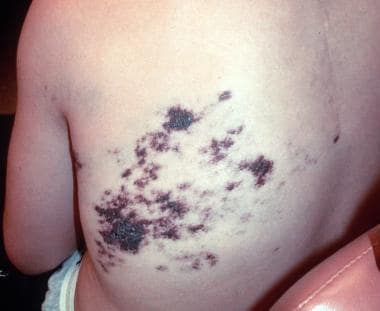Background
Cobb syndrome, or cutaneomeningospinal angiomatosis, is a rare noninherited disorder first described by Berenbruch in 1890 and described later by Cobb in 1915. [1] Patients with Cobb syndrome present with congenital cutaneous vascular lesions distributed in a dermatomal pattern with associated spinal angiomas or arteriovenous malformations (AVMs). The spinal vascular lesions can cause neurologic deficits, including paralysis. [2, 3] Early recognition of the association between the vascular skin lesions and associated spinal lesions may prevent or minimize neurological sequela. It is critical that the clinician recognize the importance of these cutaneous lesions.
Refer to the image below.
Etiology
It has been suggested that Cobb syndrome, Sturge-Weber syndrome, and PHACE syndrome (posterior fossa, hemangioma or other vascular birthmark present either on the outside or inside, arterial defect in the head and or neck area, cardiac problems, eye problems) may have a similar somatic mutation in the neural crest or mesoderm during development. The timing of this mutation during development may determine which syndrome develops. [4]
Epidemiology
Frequency
Cobb syndrome is rare; fewer than 100 cases have been reported.
Race
Cobb syndrome is reported more commonly in whites.
Sex
Cobb syndrome has a slight male predominance.
Age
Cutaneous lesions are congenital. These lesions may be subtle, and recognition of the cutaneous lesions may be delayed. The onset of neurological symptoms usually occurs in childhood or adolescence.
Prognosis
Patients who develop neurological symptoms may experience intermittent episodes of deficits that resolve, a gradual progressive deficit, or a sudden onset of paralysis. Although the most common timing for the onset of neurological symptoms is in childhood or adolescence, one case report described a 5-month-old infant with a cutaneous vascular malformation and paraparesis.
Prognosis likely depends on the severity of the spinal pathology and the timeliness of diagnosis and intervention. Patients who present with rapidly progressing neurological deficits may have a worse prognosis.
Early diagnosis is critical. Recognizing the significance of the cutaneous lesions is of upmost importance. Cobb Syndrome should be considered in any patient with cutaneous vascular lesions in a dermatomal pattern. The presence of these vascular lesions in a dermatomal pattern should prompt further evaluation for associated spinal pathology. Diagnosing these patients early may assist in preventing or minimizing potential neurological injury. Owing to the rarity of this syndrome and the varied clinical presentations, multidisciplinary teams may best serve the patient. The clinician should consider consultation with dermatologists, neurologists, neurosurgeons, and interventional radiologists.
-
Cutaneous vascular lesions. Courtesy of L. Cooke, MD.
-
Cutaneous vascular lesions. Courtesy of L. Cooke, MD.
-
Cutaneous vascular lesions. Courtesy of L. Cooke, MD.
-
MRI of spinal vascular lesion. Courtesy of L. Cooke, MD.







